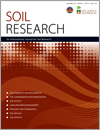SR17304Evaluating dispersive potential to identify the threshold electrolyte concentration in non-dispersive soils
This paper presents an investigation into the capability of dispersive potential as a soil specific determination of CTH in Vertosols. The practicality of dispersive potential as a method was found to be unsuitable for soils irrigated with marginal quality saline-sodic water. Therefore there is still a need to develop an efficient method to determine the CTH.





